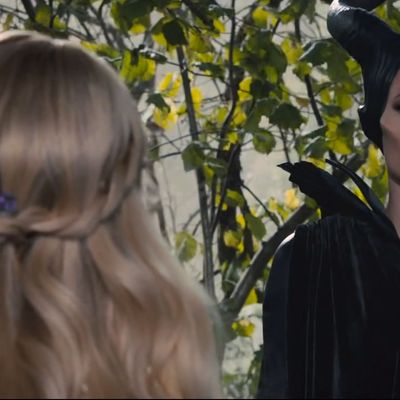
Maleficent did pretty well at the box office this past weekend, bringing in $69.4 million: one of the best openings of the year, and Angelina Jolie’s biggest opening weekend ever. A great start, then … but is it a great movie? Opinions differ: Audiences were enamored enough to give the movie a Cinemascore grade of A, but critics were more mixed, as evidenced by Maleficent’s 52 percent fresh rating at Rotten Tomatoes. No matter how you feel about the movie, though, can we all agree that these six things might have improved it? (Spoilers follow, so get out now if you’ve yet to see the film.)
A longer slumber
Aurora’s doomed sleep is the thing the entire movie has been building towards, a fate she cannot escape sprung from a curse that even the regretful Maleficent is unable to break. It ought to carry more weight than anything in the movie … and yet, it lasts about as long as a cat nap. The notion that Maleficent’s kiss is the one to break Aurora’s spell is a clever one — albeit a twist that Frozen got to first — but Maleficent’s guilt would have been a whole lot more resonant if Aurora had slept longer than the length of a scene. Why the rush to wake her up?
Smarter lines
Maleficent cuts a striking figure with those dramatic horns and sharp cheekbones, but once she opens her mouth, the spell is broken. This is through no fault of Angelina Jolie’s, an actress who can imbue any line reading with verve and passion, and should have been given better things to say by writer Linda Woolverton. Can you recall a single piece of dialogue from the film other than Jolie’s juicy reading of “Well, well,” which became the cornerstone of the film’s marketing campaign? Here, for example, is the banal exchange Maleficent has with Aurora when the two women finally meet:
Aurora: Don’t be afraid.
Maleficent: I’m not afraid.
Aurora: Then come out.
Maleficent: Then you’ll be afraid.
Shakespeare, it ain’t.
More malevolence from Maleficent
We understand that this is a revisionist retelling, and that Disney isn’t going to spend upwards of $200 million on a movie whose protagonist remains a murderous representation of pure evil. Still, couldn’t Maleficent’s villainess phase have lasted longer? She gets one scene of pure wickedness — the baby-cursing scene in the castle, yanked straight from the original animated film — and otherwise spends most of her screen time compromised by doubt and an all-too-apparent heart. To borrow a turn of phrase from Mae West: When Angelina Jolie is good, she’s very good, but when she’s bad, she’s better. Let her be wicked, full stop!
A different king
District 9 star Sharlto Copley is talented and a little bit unhinged, but from the moment he first speaks in Maleficent — and that reedy, high-pitched voice comes out — it’s clear that he’s been miscast as King Stefan. To be fair, it’s not easy to cast a man who can stand up to Angelina Jolie onscreen, but Copley comes off like he’s looking for the exits. The two of them together just didn’t work.
A stronger visual sensibility
A lot of money was spent on Maleficent’s look, but first-time director Robert Stromberg never managed to frame his shots in an interesting way, often just plopping Jolie in the center of the frame and shooting the whole big endeavor in close-up. Snow White and the Huntsman was not much better than this film — and it, too, was helmed by a first-time director — but there’s no knocking its striking images. Stromberg got this gig because of his visual-effects background, so it’s surprising that Maleficent’s visuals feel so indifferently composed.
Better fairies
Whaaaaat was up with those freaking fairies? Stromberg hired three of the best British actresses around — Imelda Staunton, Lesley Manville, and Juno Temple — but gave them nothing to play besides idiocy. It’s bad enough that they spend most of the film flying around with super-deformed motion-capture bodies, but it’s worse that the fairies’ biggest moment comes when they get in a flour fight, a sequence that has none of the ingenuity of the fairies’ big montage in Sleeping Beauty. What does it say when your movie is more juvenile than the animated film that inspired it?




